ARTICLE AD BOX
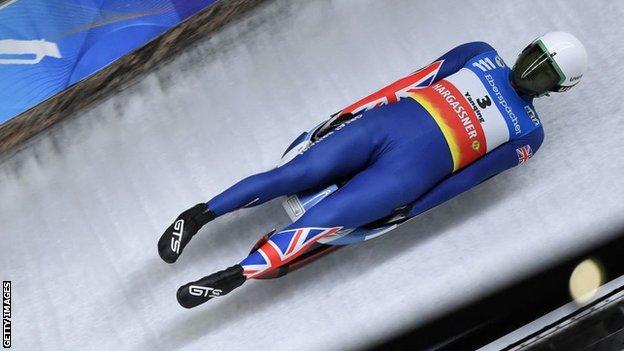 Britain's Rupert Staudinger will be competing at the Beijing Olympics in luge
Britain's Rupert Staudinger will be competing at the Beijing Olympics in luge| Hosts: Beijing, China Dates: 4-20 February |
| Coverage: Watch live on BBC TV, BBC iPlayer, BBC Red Button and online; listen on BBC Radio 5 Live and BBC Sounds; live text and highlights on BBC Sport website and app |
Athletes whizz at speeds above the motorway limit down sheer ice on small sleds in both sports - but what makes luge faster than skeleton?
Average luge speeds are 120-145km/h, with skeleton at 120-130km/h, and Luge USA even once patented the phrase 'fastest sport on ice'.
Rupert Staudinger, Team GB's only luge athlete at Beijing 2022, explains the differences and why the answer lies - of course - in simple physics.
Head first or feet first?
To the casual viewer, watching the sports at the Olympics every four years, the feet-first aspect of luge can make it seem - marginally - less terrifying than the head-first position of skeleton.
But that is misplaced if you're thinking about it in terms of speed.
The surface area of a big round helmet is much bigger than the surface area of two feet and therefore creates much more drag, which slows down the sled.
The same also applies to bobsleigh, the other of the three sliding sports.
"The cross-section of the whole area of the bob is so much bigger so that makes it slower in relation to us because we have a smaller cross-section area with less drag," Staudinger, 24, explained.
Luge athletes wear smooth boots to further reduce drag.
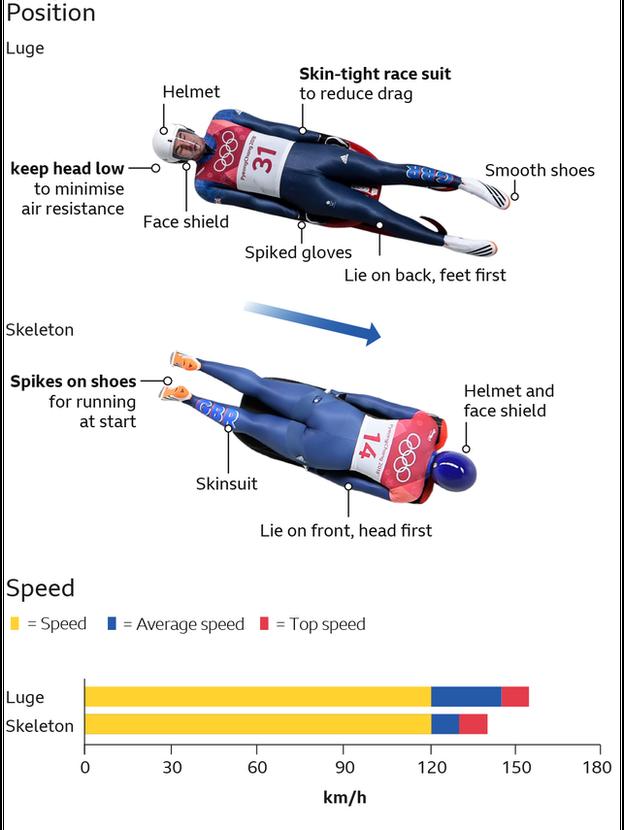
It's all about the start
You might think that the standing start in skeleton and bobsleigh, where athletes push the sled while sprinting before jumping on board, would result in faster top speeds on the track.
But luge athletes start seated - so how does that work?
It's all about the ramp. When luge athletes push off the bars and paddle themselves forwards with their hands in spiked gloves on the track, they are starting above the track and drop down a slope on to it.
"On flat ice that wouldn't be quicker but as we have the ramp that's higher up we are faster from the start on," Staudinger said.
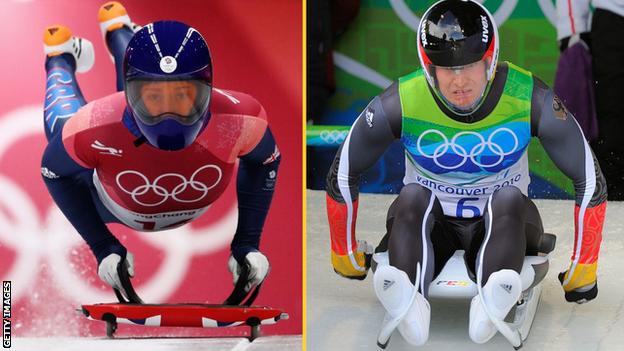
Steering - practice makes perfect
In all the sliding sports, steering to as close to a perfect line as possible is key to success - obviously, the more you hit the sides, the more speed you lose.
Generally speaking, luge athletes have had a lot longer to finesse this.
Skeleton and bobsleigh are often 'second sports' for athletes who have come from track and field, while luge is taken up at a young age.
"In luge, people just seem to make it to the top when they start really young, so it comes down to experience," said Staudinger
"It needs a lot of driving experience, so you have to get into the sport very soon, whereas in bobsleigh and skeleton people have to run fast to be on the top so driving skill is not as important as the start speed.
"Luge is something completely different - the feeling of the sled, it takes years to gain that. How do I have to listen to my body? How does it feel when I drift? Or how far can I drop the angle - that comes with experience and what my body senses."
The luge is steered mainly from the feet, with calves resting on kufens, and athletes also use their upper body to try to smooth out the entrances and exits off the corners by leaning into the curve to make it as soft as possible.
In skeleton the steering comes from mainly the head and shoulders, as well as the knees and sometimes the toes tap on the ice to help too.
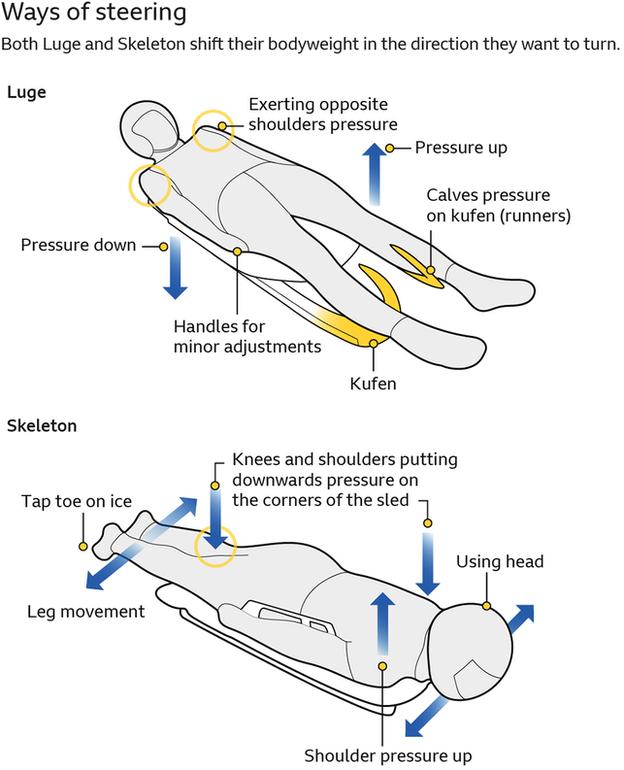
Weight is helpful - but in the right places
In luge there is no maximum weight for athletes. More weight can help with speed - but it needs to be in the right place.
"You want to be heavier but without having a huge tummy because that would mean worse aerodynamics obviously!" Staudinger said. "You want to keep the cross-section area as small as possible."
Men who weigh less than 90kg can add up to 13kg (10kg for women less than 75kg), which they can do by wearing a lead-weighted vest or wrapped around their thighs.
The sled itself must weigh between 21kg and 25kg in singles.
There are weight limits in skeleton, where the combined maximum of the athlete and the sled is 115kg for men and 92kg for women, with the sled weighing no more than 33kg for men and 29kg for women. Any additional weights in skeleton are added to the sled rather than to the athlete within those limits.
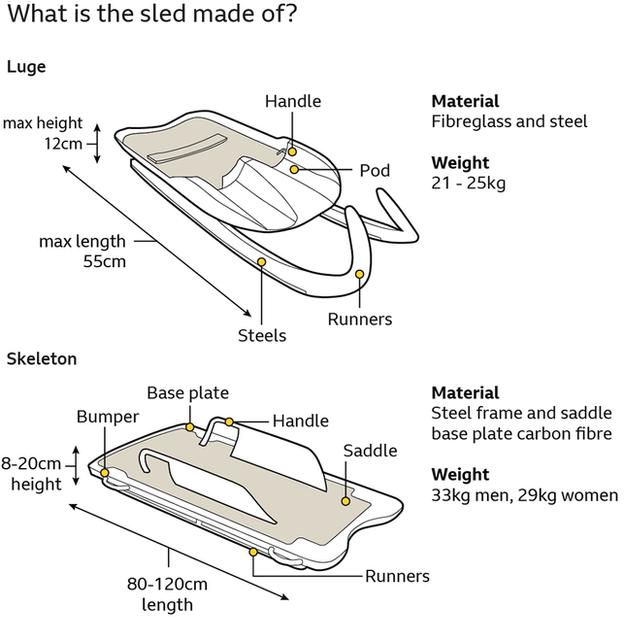
A lot in common with Formula 1
Luge athletes can face G-Forces of up to 6G - that means their bodies feel six times heavier than normal to them.
It is similar to what Formula 1 racing drivers experience and so is much of the way Staudinger trains.
"Because there is a lot of G-Forces that strain the neck I do a lot of neck work, a lot of core stability, similar to Formula 1," said.
And even the experience of racing down the luge track is "like driving a fast car" in that if you look forwards you can see clearly but things to the side are blurry. Although when you are racing you want to have your head back to help aerodynamics so you rely on memory points to navigate the track.
Staudinger says he has been down the Olympics track in Yanqing around 20 to 30 times and feels comfortable on it.
"It's absolutely gigantic, it's definitely the biggest track - it's quite long, it's a very challenging one because you have to steer quite hard on it," he said.
"The bobsledders and skeleton guys said the same, it's quite a challenging track."
But we know who is likely to be going the fastest on it.

 2 years ago
22
2 years ago
22








 English (US) ·
English (US) ·